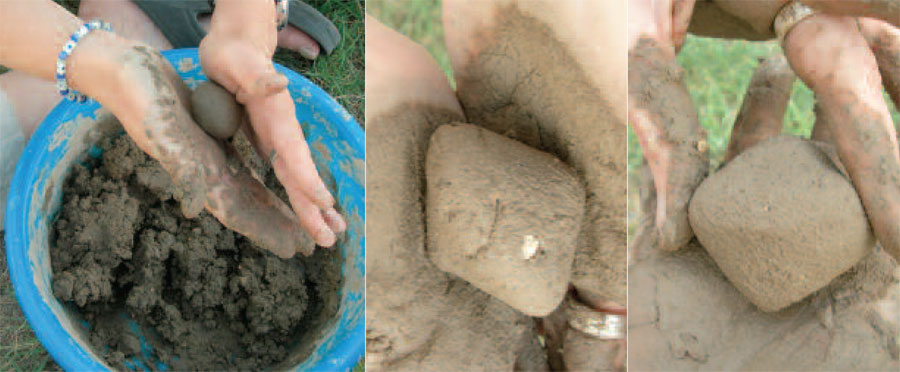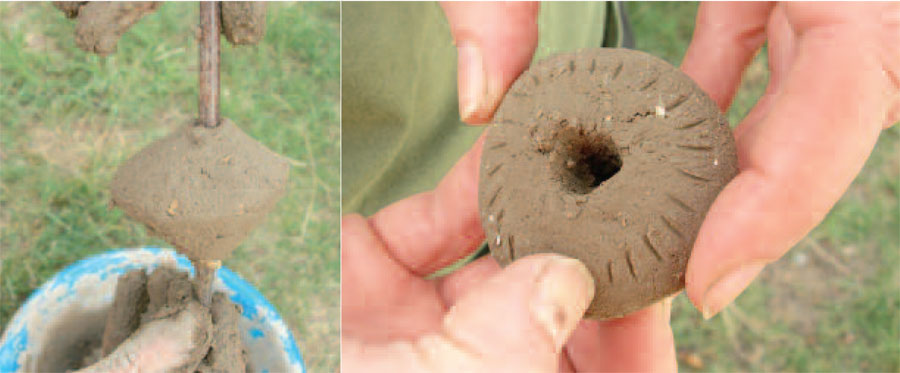
(middle) Our first attempt produced an asymmetrical biconical shape (two rounded cones, base-to-base).
(right) It did not take much practice to create a symmetrical shape.
A surprising amount of archaeological discovery consists simply of connecting the disparate bits of information that an average archaeologist holds in her mind. Such a connection occurred recently at the Museum’s research project in Gordion, Turkey, leading us to a new insight into ancient textile production.
In June 2006 we began testing a new approach to the conservation of excavated stubs of ancient stone walls. In collaboration with Frank G. Matero, Professor of Architecture and Chair of Penn’s Program in Historic Preservation, we put a “soft cap” of soil atop one exposed wall of the ancient ruins to allow shallow-rooted plants to grow. Our aim is to reduce the internal moisture and temperature variability within the walls, and we hope, help stabilize the masonry from further degradation.
To this end, one of us (Miller) collected local wild seeds from plants that are most likely to hold the soil in place. Inspired by a traditional agricultural technique used by Pueblo Indians in the American Southwest, we put some of these seeds in mudballs that will melt in place on the wall tops during the winter rains. To make the mudballs, we rotated a soil and clay mix between the palms of our hands with a simple circular motion. Imagine our surprise when we realized that the default shape of a mudball was biconical, the same shape as a biconical spindle whorl—a weight used in spinning fiber by hand!
Spindle whorls are found all over the world, made of stone, bone, ceramic, and other materials. They occur in a variety of shapes. The earliest known ceramic spindle whorls from the Near East are of this easy-to-form biconical shape. A large assemblage of such whorls, for example, comes from Hajji Firuz, a 7th-millennium BC Neolithic site in Iran that was excavated by the Museum in the 1970s. Did ancient spinners make biconical spindle whorls just because it was easy, or is there a special utility to this shape?
The best shape and weight for a spindle whorl depends on the kind of fiber to be spun. For example, the biconical type, which is heaviest toward the center, is most suitable for fibers needing a lot of twist. This is the case when spinning flax, which has relatively smooth fibers. In contrast, wool has short “crimped” fibers and does not need a lot of twist to be spun into yarn.
In ancient West Asia, two main fibers were used to produce cloth—linen from the flax plant and wool from sheep. Based on rare archaeological finds, linen—which preferentially would have been made using biconical spindle whorls— seems to have preceded wool. Given the centrality of cloth in ancient economies, knowing which fiber was spun would give us clues about how a society organized its agriculture, herding, textile production, and social relationships. Given the absence of rarely preserved cloth, our discovery suggests a new way for archaeologists to infer the type of cloth produced.

(right) The next day we made fingernail impressions in the leather-hard clay, recalling ancient decorations on spindle whorls.
Beyond serendipity, this exercise in experimental archaeology reminds us how important it is to appreciate and try to understand the knowledge of people who work with their hands, both today and in the past. As the seed-filled mudballs reflect the knowledge and practice of Pueblo Indian farmers, biconical whorls reflect the knowledge and skill of ancient Near Eastern spinsters.
Also see “Mudball: The Movie” at http://www.sas.upenn.edu/~nmiller0/mudball.html
